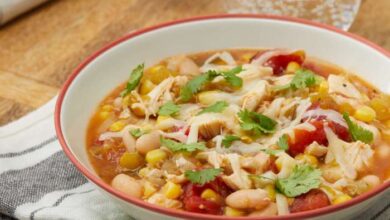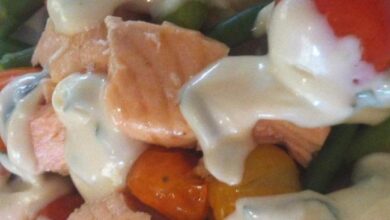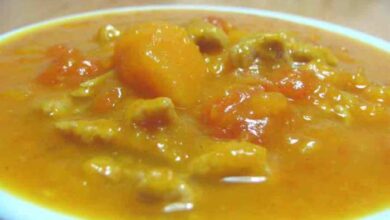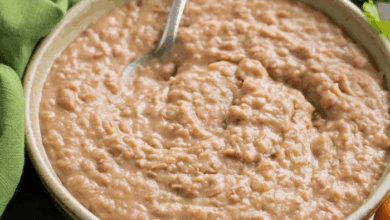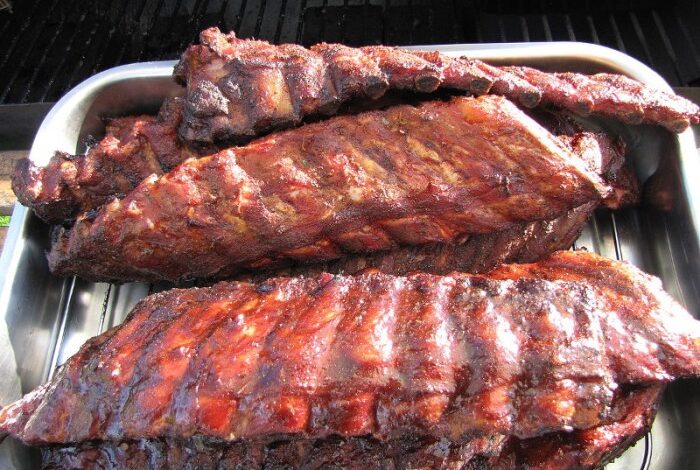
Slow Cooker Barbecue Ribs: Tender, Flavorful, and Easy
Slow cooker barbecue ribs set the stage for a culinary adventure, offering a delightful blend of smoky, savory, and tender flavors. The slow cooker, a kitchen hero, effortlessly transforms tough cuts of meat into melt-in-your-mouth masterpieces. Imagine the aroma of slow-cooked ribs filling your home, inviting you to savor the fruits of your labor.
The magic of slow cooking lies in its ability to break down tough connective tissues, rendering the ribs incredibly tender. The low and slow cooking process allows the flavors to meld and deepen, resulting in a truly satisfying experience. Whether you’re a seasoned grill master or a novice cook, slow cooker barbecue ribs offer a foolproof way to impress your family and friends with a meal that’s both delicious and effortless.
Barbecue Sauce Options
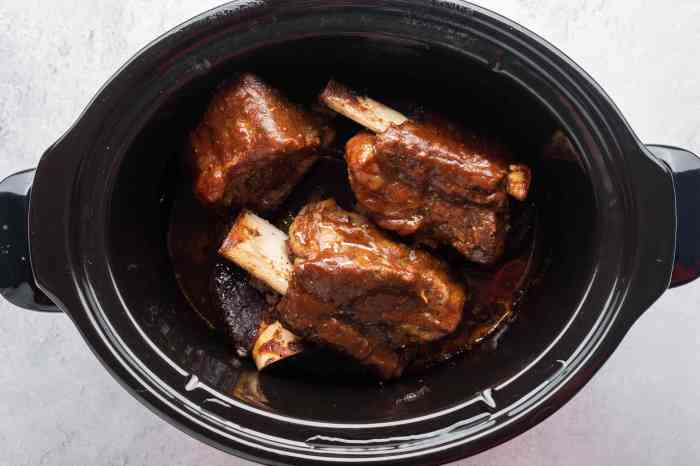
Barbecue sauce is the crowning glory of slow-cooked ribs, adding a layer of flavor that elevates the dish to new heights. The right sauce can transform your ribs from good to unforgettable, so choosing the right one is crucial. This section will explore different types of barbecue sauces, providing recipes and insights into the importance of consistency and application timing.
Types of Barbecue Sauces, Slow cooker barbecue ribs
The world of barbecue sauce is vast and diverse, with regional variations that reflect local culinary traditions and preferences. Here is a comparison of some popular types:
| Sauce Type | Region | Key Characteristics | Common Ingredients |
|---|---|---|---|
| Kansas City | Kansas City, Missouri | Sweet, tangy, and slightly smoky | Tomato ketchup, brown sugar, molasses, vinegar, Worcestershire sauce |
| Carolina | North Carolina | Vinegar-based, tangy, and thin | Vinegar, black pepper, mustard, sometimes a touch of sugar |
| Memphis | Memphis, Tennessee | Dry rub-based, with a sweet and smoky flavor | Dry rub ingredients (paprika, brown sugar, salt, pepper, garlic powder) |
| Texas | Texas | Thick, smoky, and often spicy | Tomato sauce, brown sugar, chili powder, cumin, black pepper |
| Alabama White | Alabama | Creamy, tangy, and often sweet | Mayonnaise, vinegar, sugar, black pepper, cayenne pepper |
Barbecue Sauce Recipes
Here are some recipes for different types of barbecue sauce:
Sweet and Smoky Barbecue Sauce
Ingredients:
- 1 cup ketchup
- 1/2 cup brown sugar
- 1/4 cup apple cider vinegar
- 1/4 cup Worcestershire sauce
- 2 tablespoons smoked paprika
- 1 tablespoon chili powder
- 1 teaspoon garlic powder
- 1 teaspoon onion powder
- 1/2 teaspoon black pepper
- 1/4 teaspoon cayenne pepper (optional)
Instructions:
- Combine all ingredients in a saucepan.
- Bring to a simmer over medium heat.
- Reduce heat and simmer for 15 minutes, stirring occasionally.
- Let cool slightly before using.
Tangy Barbecue Sauce
Ingredients:
- 1 cup apple cider vinegar
- 1/2 cup brown sugar
- 1/4 cup Dijon mustard
- 2 tablespoons Worcestershire sauce
- 1 tablespoon smoked paprika
- 1 teaspoon garlic powder
- 1/2 teaspoon onion powder
- 1/4 teaspoon black pepper
- 1/4 teaspoon cayenne pepper (optional)
Instructions:
- Combine all ingredients in a saucepan.
- Bring to a simmer over medium heat.
- Reduce heat and simmer for 10 minutes, stirring occasionally.
- Let cool slightly before using.
Spicy Barbecue Sauce
Ingredients:
- 1 cup ketchup
- 1/2 cup brown sugar
- 1/4 cup apple cider vinegar
- 1/4 cup Worcestershire sauce
- 2 tablespoons chili powder
- 1 tablespoon smoked paprika
- 1 teaspoon garlic powder
- 1 teaspoon onion powder
- 1/2 teaspoon black pepper
- 1/4 teaspoon cayenne pepper (optional)
Instructions:
- Combine all ingredients in a saucepan.
- Bring to a simmer over medium heat.
- Reduce heat and simmer for 15 minutes, stirring occasionally.
- Let cool slightly before using.
Sauce Consistency and Application Timing
The consistency of your barbecue sauce plays a vital role in how it adheres to the ribs and develops its flavor. Thicker sauces are ideal for basting, while thinner sauces are better for mopping.
Basting:Apply a thick sauce towards the end of the cooking process to create a caramelized glaze. Mopping:Use a thin sauce throughout the cooking process to keep the ribs moist and flavorful.
The timing of sauce application is also crucial. Applying sauce too early can lead to a burnt and overly sticky sauce. It’s best to reserve the sauce for the final hour of cooking, basting or mopping the ribs to create a delicious and glossy finish.
Slow cooker barbecue ribs are a classic comfort food, perfect for a relaxed weekend meal. The slow cooking process creates incredibly tender meat, bursting with smoky flavor. While the ribs are simmering away, you can whip up a delicious side dish like a blue ribbon apple crumb pie – the sweet and tart filling complements the savory ribs beautifully.
And with the ribs already taking care of themselves in the slow cooker, you’ll have plenty of time to enjoy the pie while it’s still warm!
Serving and Presentation: Slow Cooker Barbecue Ribs

Barbecue ribs, with their smoky aroma and tender meat, are a culinary delight that deserves a presentation as impressive as their flavor. Creating a visually appealing table setting and accompanying the ribs with complementary side dishes can elevate the dining experience to new heights.
Slow cooker barbecue ribs are a classic comfort food that’s perfect for a weekend meal. They’re so easy to make, you can practically set it and forget it! To make it a complete meal, I always pair them with a side of creamy mashed potatoes.
But when I’m feeling extra prepared, I make a batch of twice baked potatoes for the freezer so I can easily grab a side dish any night of the week. That way, I can enjoy those tender, flavorful ribs with a delicious side without the extra prep work.
Table Setting Design
A well-designed table setting can enhance the enjoyment of any meal, especially one as special as barbecue ribs. To create a visually appealing presentation, consider the following:
- Rustic Charm:Use wooden serving platters or bowls to complement the smoky flavors of the ribs. Natural textures like woven placemats or burlap runners add a touch of rustic elegance.
- Color Palette:Choose a color palette that reflects the warm and inviting nature of barbecue. Think shades of brown, red, orange, and yellow. Use checkered tablecloths or napkins for a classic barbecue look.
- Lighting:Dim lighting can create a cozy and intimate atmosphere, enhancing the visual appeal of the food. Use candles or string lights to add warmth and ambiance.
- Garnishes:Fresh herbs like parsley or cilantro, sliced lemons, or a sprinkle of paprika can add a pop of color and freshness to the presentation.
Accompanying Side Dishes
The perfect side dishes complement the flavors of barbecue ribs, creating a balanced and satisfying meal. Here are some popular options:
- Coleslaw:A refreshing and tangy coleslaw provides a nice contrast to the rich and smoky ribs. Classic coleslaw recipes often feature mayonnaise, vinegar, and shredded cabbage, but you can get creative with variations like adding chopped apples, cranberries, or even pineapple.
- Baked Beans:Sweet and savory baked beans are a classic barbecue side dish. They can be made from scratch or purchased pre-made, and often include ingredients like molasses, brown sugar, and bacon.
- Potato Salad:A creamy and comforting potato salad adds a starchy element to the meal. Classic potato salad recipes typically include mayonnaise, mustard, and chopped celery, but you can experiment with variations like adding dill, chives, or even a touch of horseradish.
- Cornbread:A warm and crumbly cornbread adds a touch of sweetness and texture to the meal. Serve it alongside the ribs, or offer it as a side dish with butter or honey.
Garnishing and Presentation
Garnishing and presentation play a crucial role in enhancing the dining experience. They not only make the food visually appealing but also stimulate the senses, creating a more memorable and enjoyable meal.
Slow cooker barbecue ribs are a real crowd-pleaser, especially when you’re looking for a comforting and easy meal. While the ribs are bubbling away in the slow cooker, you can whip up a batch of old fashioned bread pudding to complement the smoky ribs.
The rich, creamy pudding adds a sweet contrast to the savory ribs, making for a truly satisfying meal.
- Color Contrast:Use garnishes that provide a contrasting color to the ribs, such as green herbs or bright red tomatoes. This creates a more visually appealing and interesting presentation.
- Texture Variety:Incorporate garnishes with different textures, such as crunchy vegetables or creamy sauces. This adds a layer of complexity to the presentation and enhances the overall sensory experience.
- Aroma Enhancement:Choose garnishes that complement the aroma of the ribs, such as fresh rosemary or thyme. These herbs can enhance the overall fragrance of the dish.
Variations and Alternatives
While slow cooking is a fantastic method for achieving tender and flavorful ribs, it’s not the only way to cook them. Exploring other techniques and experimenting with different flavors can elevate your barbecue experience.
Alternative Cooking Methods
There are other popular methods for cooking barbecue ribs, each with its own unique characteristics.
- Smoking: Smoking ribs over low heat with wood chips imparts a rich, smoky flavor and creates a tender, juicy texture. The slow and steady cooking process allows the meat to break down and absorb the smoky aroma.
- Grilling: Grilling ribs over direct heat can achieve a crispy exterior and a smoky flavor, although it requires careful attention to prevent burning. Grilling is often used in conjunction with smoking, where the ribs are initially smoked and then finished on the grill for a final sear.
Flavor Variations
You can customize your slow cooker barbecue ribs with different marinades and flavor profiles to suit your taste preferences.
- Spicy Ribs: Enhance the heat with ingredients like chili powder, cayenne pepper, and habanero peppers. A marinade with a blend of these spices can create a fiery and flavorful kick.
- Sweet and Smoky Ribs: Combine sweet and smoky flavors by using ingredients like brown sugar, molasses, and smoked paprika. A marinade or sauce incorporating these ingredients can deliver a balanced and satisfying taste.
- Asian-Inspired Ribs: Introduce Asian flavors with ingredients like soy sauce, ginger, garlic, and sesame oil. A marinade with these components can create a savory and aromatic experience.
Alternative Meats
While pork ribs are a classic choice for barbecue, other cuts of meat can also be cooked using the slow cooker method.
- Pork Shoulder: Pork shoulder is a versatile cut that benefits from slow cooking, resulting in tender and flavorful pulled pork. It can be seasoned and cooked similarly to ribs, with a longer cooking time required for optimal tenderness.
- Beef Brisket: Beef brisket is a large and fatty cut that is ideally suited for slow cooking. The slow and low heat breaks down the tough connective tissues, creating a melt-in-your-mouth texture. A marinade or sauce with a smoky or savory flavor profile complements the beef brisket well.
Tips and Tricks
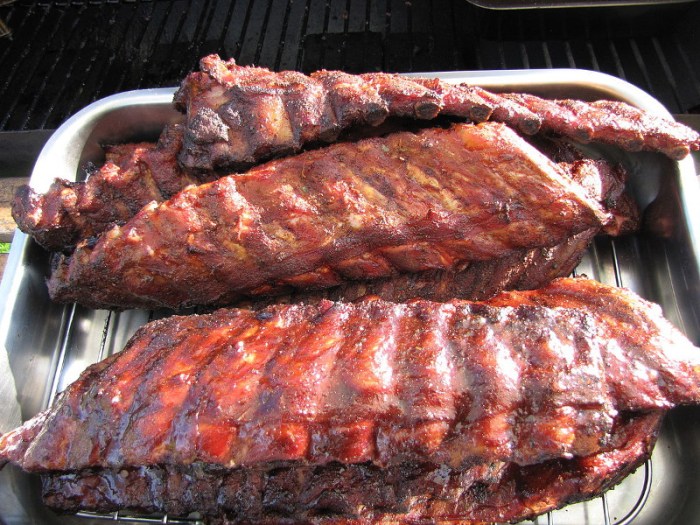
Mastering the art of slow-cooked barbecue ribs is all about patience and a few key tricks. Whether you’re a seasoned grill master or a novice in the kitchen, these tips will help you achieve melt-in-your-mouth tenderness and a mouthwatering smoky flavor.
Ensuring Tender Ribs
- Start with the Right Cut:Baby back ribs are generally preferred for slow cooking due to their tenderness and flavor. Spare ribs are another option, but they can be tougher and require longer cooking times.
- Trim Excess Fat:Removing excess fat from the ribs helps prevent them from becoming overly greasy. However, leave a thin layer of fat on top to help keep the ribs moist during cooking.
- Season Generously:Don’t be shy with the seasoning! A good rub will add depth of flavor and help create a crispy bark on the ribs.
- Slow and Low:The key to tender ribs is cooking them low and slow. Aim for a temperature of 225-250°F (107-121°C) for at least 4-6 hours.
- Liquid is Key:The slow cooker needs enough liquid to prevent the ribs from drying out. Use a flavorful broth, beer, or even apple cider for extra moisture and flavor.
- Foil Wrap:Wrapping the ribs in foil during the first half of the cooking time helps create a steamy environment, which promotes tenderness. Unwrap the ribs for the last hour to allow the bark to crisp up.
Troubleshooting Common Issues
- Dry Ribs:If your ribs are dry, it’s likely because they weren’t cooked long enough or there wasn’t enough liquid in the slow cooker. Add more liquid and continue cooking until the ribs are tender.
- Ribs Not Falling Off the Bone:Ribs that don’t fall off the bone might not have been cooked long enough. Check for tenderness by gently pulling on a rib bone. If it comes out easily, the ribs are ready. If not, continue cooking for another 30-60 minutes.
Storing and Reheating Leftovers
- Storing:Leftover ribs can be stored in an airtight container in the refrigerator for up to 3-4 days.
- Reheating:Ribs can be reheated in the oven at 350°F (175°C) for 15-20 minutes, or in the microwave for 1-2 minutes per rib.

